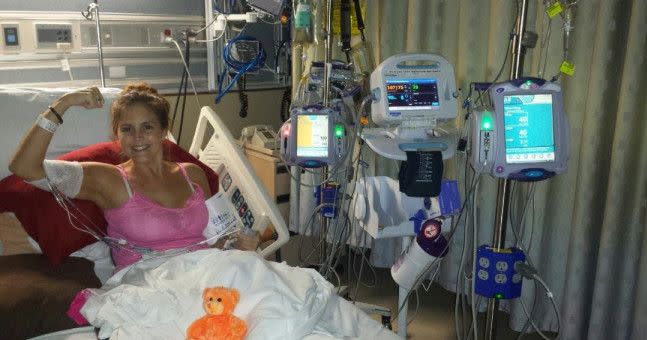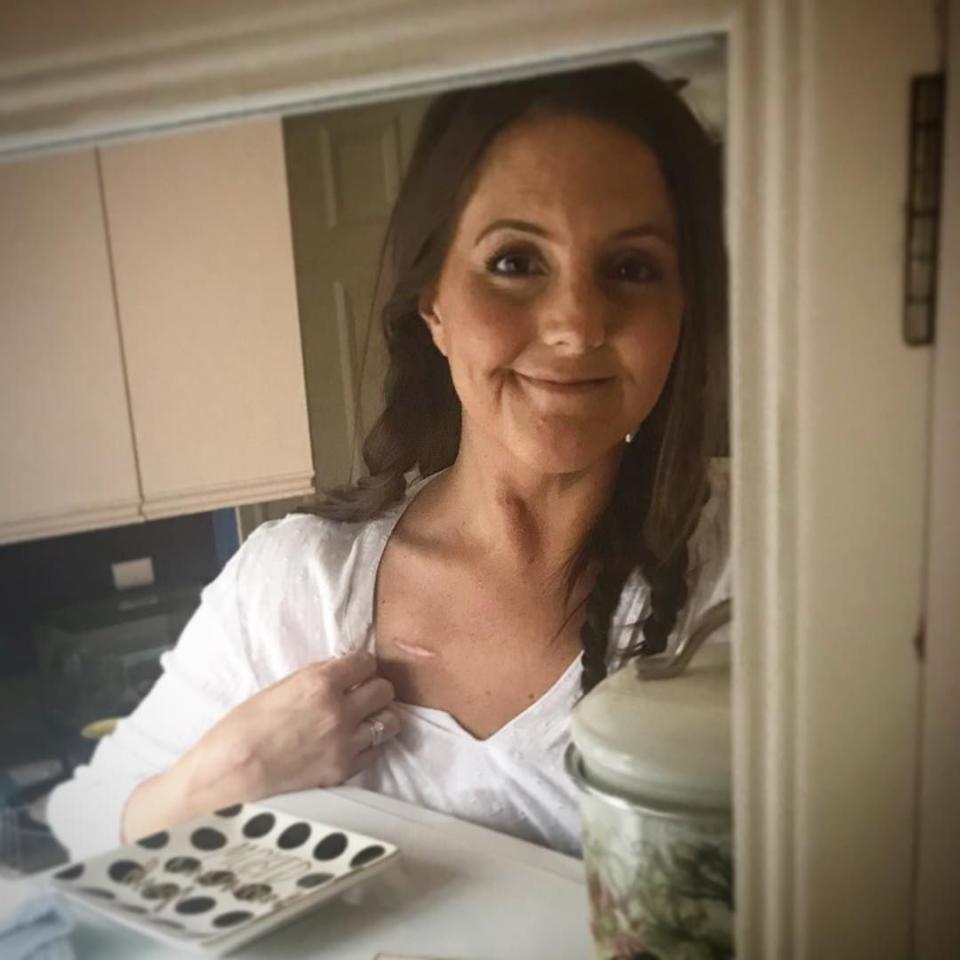I Tried 22 Different Medications Before an Electrical Implant Healed My Crohn's Disease

When I was in the eighth grade, my life changed forever. I was tap dancing during a play rehearsal and twisted my ankle. It sounds pretty innocuous, right? But what followed was a big shock. At first, the swelling in my ankle seemed normal. After a few weeks my ankle was just as swollen as the day it happened. So, I went to an orthopedist. He used a needle to drain the fluid, but by that night it was back to being puffy and sore.
Around the same time, I started having stomach issues. I'd literally go to the bathroom 15 to 20 times a day. When I mentioned this to my orthopedist, he began to suspect there may be more going on and sent me to the hospital for a colonoscopy.
It wasn't long after that I was diagnosed with Crohn's disease, which was showcasing itself as colitis and inflammatory arthritis. Life as I knew it was over. I went from being an athletic 13-year-old girl who played just about every sport to feeling like I was 80 years old. Over the next few years, the arthritis spread to every joint in my body and I struggled with pyoderma gangrenosum—skin ulcers that looked like big, gaping wounds and would take up to 18 months to heal. Rather than pizza parties and trips to the mall with friends, my life became a long stream of doctors appointments, new medicines, and even hospital stays. I was forced to grow up quickly.
How My Crohn’s Progressed
Many people don’t realize that there are five different types of Crohn's disease. In some patients, Crohn's only shows up in their colon. Other patients see it spread from their colon to their joints, skin, and even eyes. In my case, it seemed to start from the bottom and move up. By the time I was 25, I had inflammatory arthritis in my hands, fingers, elbows, jaw, shoulders, back, hips, knees, toes, and ankles. I was constantly in pain.
Since my diagnosis, I have been on 22 different drugs to try and help with symptoms. Some would work for a short period before my body built up antibodies against them, others wouldn't work at all. The only thing that seemed to really help for a while was a steroid called prednisone. Unfortunately, this drug also weakens your bones and around the time I turned 25, I was diagnosed with osteoporosis in my spine and hips.

Desperate for Better Treatments
Even with all of this going on, I managed to graduate college and get a job teaching high school English—something I am very proud of. But working on my feet all day was tough. After work, I'd spend each night on my couch icing my knees.
One night in 2014, I came across a video of Dr. Kevin Tracey, CEO and president of the Feinstein Institutes for Medical Research at Northwell Health. He was talking about a new implant that released electric currents to regulate the vagus nerve in order to treat rheumatoid arthritis and other inflammatory diseases. I reached out to him immediately, told him my story, and said, “What do I have to do to get this device?” At that point, the only clinical trials open were for rheumatoid arthritis, but Dr. Tracey was hopeful new trials would expand to Crohn's down the road.
I filed that information away and held out hope I could one day get the implant. In the meantime, my body quickly deteriorated. In 2015, I was devastated when I had to stop working because of a colitis flare that led me to lose weight drastically and become hospitalized. I was even more upset in 2017 when my doctor told me there were no more medications left to try. He told me I'd have to take high-dose steroids to manage my symptoms. While they'd help me feel better in the short term, I knew taking them wasn't good for the long term health of my bones. Can you imagine having to choose between agonizing pain or keeping your bones strong?
It was during this time that I remembered Dr. Tracey. I wondered if new trials started to study Crohn's disease, so I searched clinicaltrials.gov to see if I could find any information. I was excited to see that a company called Setpoint Medical had developed Dr. Tracey's implant for Crohn's and was running a clinical trial.
I emailed to see if I could join the trial and they got back to me fairly quickly saying that I qualified. But then they threw me a curve ball. To be part of the study, I'd have to move to Amsterdam for six months. I knew my husband would be supportive, but I just didn't know how we would manage. We basically sold everything that wasn't nailed to the floor, raised about $16,000 and set off for Amsterdam.
I received the implant on July 6, 2017. It was amazing how quickly I noticed improvement. Within a few weeks, my knees had gone from the size of cantaloupes to totally normal. I can remember exclaiming to my husband, “Oh my god! We can see my kneecaps!”
On September 1, 2017, I was deemed in clinical remission for the first time since I was diagnosed 15 years earlier. I felt like a new woman. I could live like a totally normal person. My stomach no longer hurt and after two years, the osteoporosis in my spine and right hip also reversed itself.
A New Take on Life
When I got home from Amsterdam, I was compelled to reach out to Dr. Tracey. I wanted him to know that his research had saved my life. He was so kind and invited me to visit his lab and meet him in person. We hit it off and over the next year, I began speaking about the benefits of bioelectronic medicine at different events through the Feinstein Institutes. My implant had helped me so much and I wanted to get the word out to other people.
A year later, Dr. Tracey brought me on as the director of education and outreach for the Feinstein Institutes. Now, it's my job to work with patients who are interested in learning how bioelectronic medicine could help them. The implant isn’t approved by the FDA yet, so you have to be part of a clinical trial to get it. We now have a database of about 1,000 patients who are anxiously awaiting their turn for clinical research to happen and we inform them when something is in the works that might be a fit for them. (Patients who want more info about this are welcome to email me at kowens4@northwell.edu.)

There's still some skepticism around bioelectric medicine, so we also try to educate both patients and physicians. Generally speaking, there hasn't been much of an understanding around the intimate way that the nervous system interacts with the immune system. Bioelectronic medicine shows us that, through specific neural signals, we can help the immune system respond in a targeted way. For example, the vagus nerve starts in the brain, goes down the neck, and branches to all the major organs of the body. When it’s electrically stimulated, it can send a signal to the spleen letting it know it’s creating too much inflammation, and the spleen adjusts itself.
Looking to the Future
My implant requires me to manually swipe a magnet over a battery in my chest every day to electrically stimulate the vagus nerve. However, newer devices have microregulators that don’t require a battery—you can program them from an iPad so they automatically turn on when they’re supposed to.
I remember during really rough times, I'd remind myself that my current situation was not my final destination. That hope is what kept me going and motivated me to continue looking for new solutions. There is so much research happening around Crohn's disease and I urge people who are struggling to dig into the research—you may just find something that will help you.
Kelly Owens is director of education and outreach at the Feinstein Institutes for Medical Research at Northwell Health and lives with her husband in Rye, New York.
Like what you just read? You’ll love our magazine! Go here to subscribe. Don’t miss a thing by downloading Apple News here and liking Prevention. Oh, and we’re on Instagram too.
You Might Also Like
